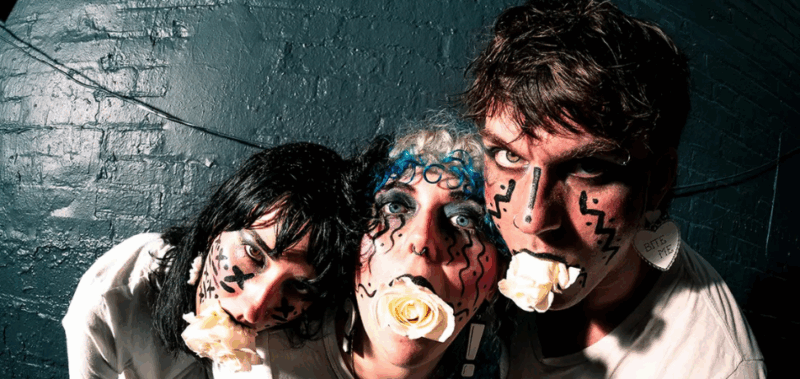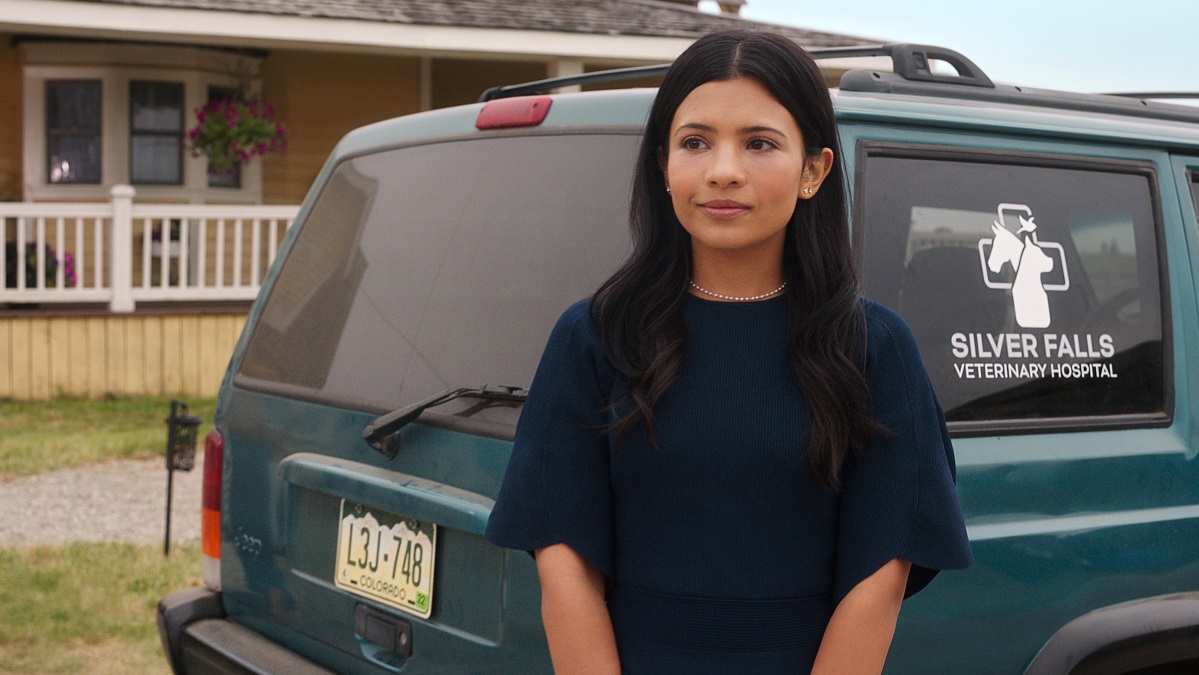This glowing, otherworldly dress is made from millions of living organisms
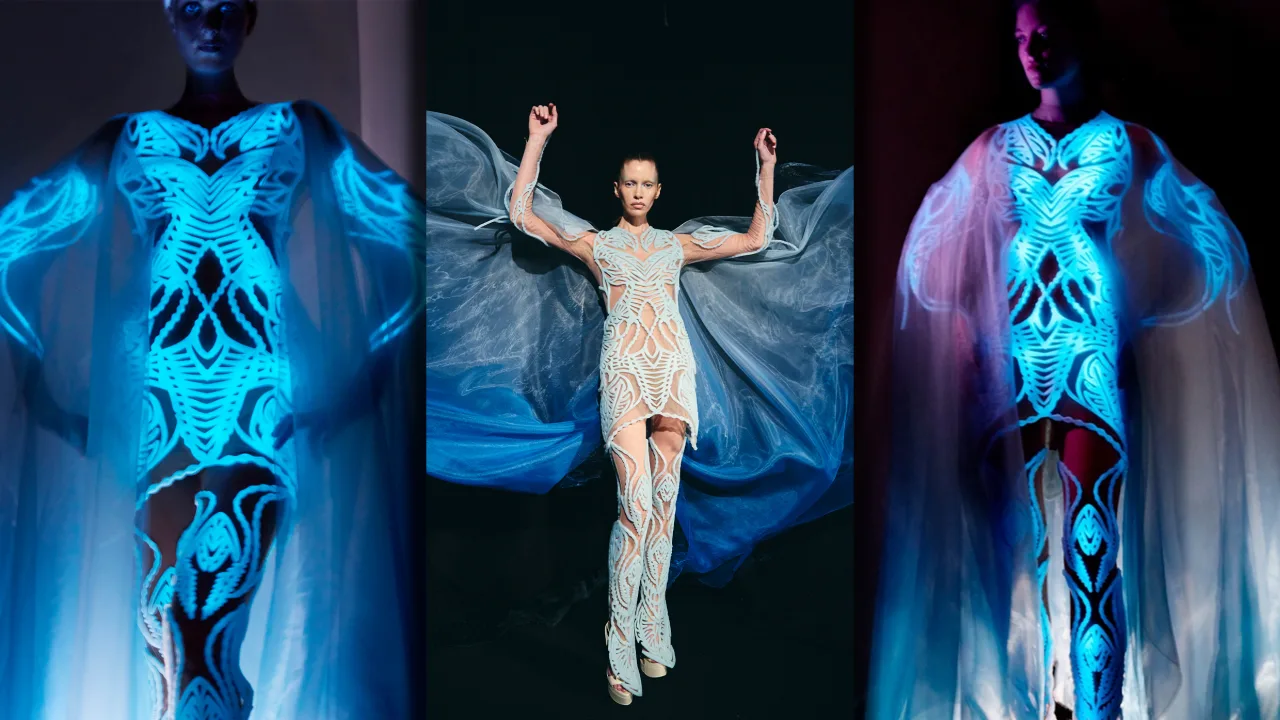
High-fashion model Stella Maxwell got dressed for Iris van Herpen’s most recent haute couture show in the dark. Around her, flashes of ultra-dim red light—designed to maintain the illusion of night—were the only respite that allowed stylists to slip her into the show’s opening gown. As the stylists worked to fasten the garment around Maxwell, it became the room’s source of illumination. Every small bit of pressure applied to the fabric caused it to glow an otherworldly blue. That’s because Maxwell’s dress was made of living, touch-activated, bioluminescent organisms.
The gown was revealed on July 7 as the debut look of Sympoiesis, Van Herpen’s Autumn/Winter 2025-2026 show at Paris Fashion Week. Crafted in collaboration with biodesigner Chris Bellamy, who runs his own studio called Bio Crafted, the dress is made of 125 million Pyrocystis lunula, a form of microalgae that evolved to emit light when touched.
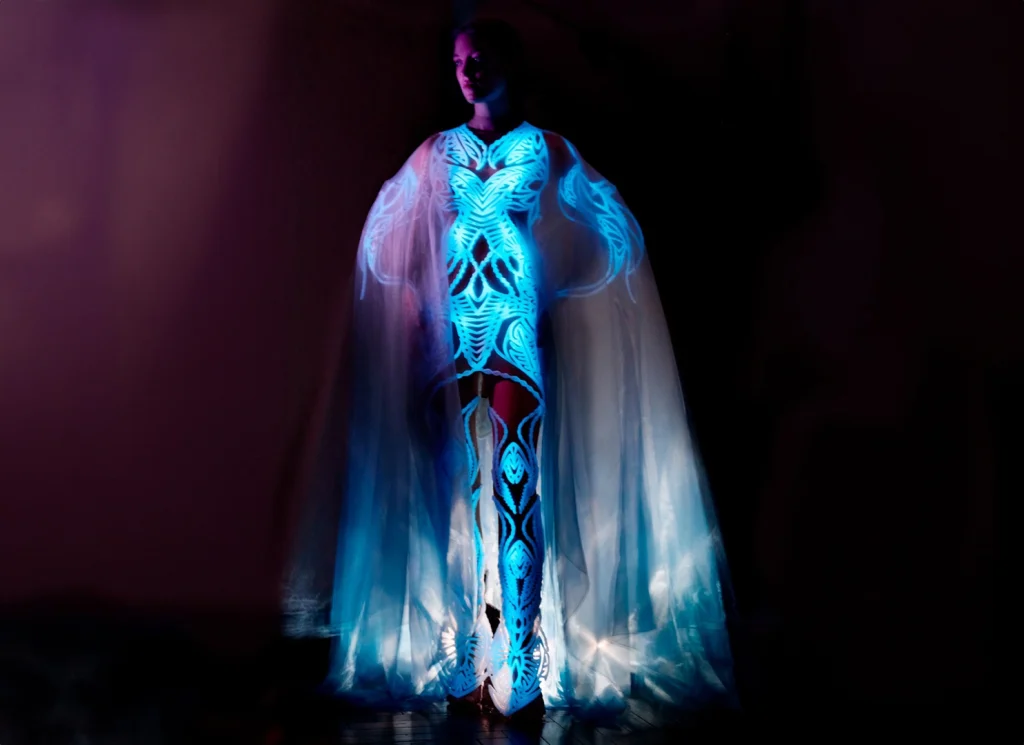
Fashion designers often talk about bringing a look to life, but in this case, Van Herpen requested that Bellamy quite literally design a living dress. While the Dutch designer has experimented broadly with material science and sustainable fashion in the past—building 3D-printed shoes, fabric made from trash, and gowns crafted from ocean plastic—this is the first time she’s sent living organisms out onto the runway.
To make it happen, Bellamy was tasked with not only shepherding millions of microalgae through their early life cycle in just two months, but also finding a way to keep them alive on a moving garment. He says that involved reviving the dress just days before the show.
The quest for “biological dark matter”
Bellamy, who started his career in engineering, says he’s always had an interest in “working on the cutting edge of sustainability.” He helped develop Jaguar Land Rover’s first-ever electric vehicle, the Jaguar I-Pace, and later tried his hand in the footwear industry by designing recyclable shoes for the brand Salomon.
During those early years, though, Bellamy came to feel that his projects were either reliant on materials that ultimately weren’t sustainable enough to make a major difference, or on humans to dispose of them correctly (case in point, he says, is that most customers didn’t actually recycle the recyclable shoes). Ultimately, these frustrations led him to abandon his early career and follow the less-charted path of biodesign.
At Bio Crafted, Bellamy focuses on finding new ways to incorporate living materials into everyday life and products. That goal introduced him to a field called bioprospecting, which involves searching for as-yet-undiscovered microorganisms and learning their unique properties.
“They say that for every one organism we know, there are 100,000 that we don’t know,” Bellamy says. “That 100,000 is termed ‘biological dark matter,’ and in that there might be new cancer treatments, there might be new vaccines, there might be things that we can’t even possibly imagine.”
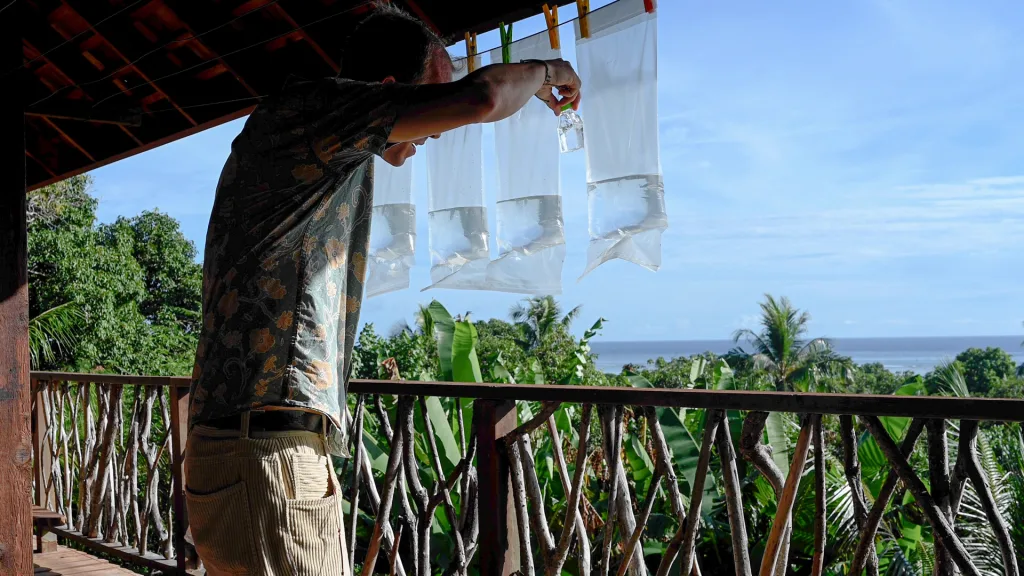
In 2023, Bellamy’s quest for this “biological dark matter” led him to the French Polynesian island of Moorea. There, he collaborated with artist and researcher Tokainiua Jean-Daniel Devatine and cultural educator Tekoui “Jérémie” Tamari on a project called “Lucid Life,” which used existing Indigenous science to create a collection of living objects out of two local strains of bioluminescent algae.
In their natural deep ocean habitats, these microorganisms evolved an energy-efficient way to scare off predators. Whenever pressure is applied to the algae—by, say, a small fish—the algae activate a chemical reaction to emit light. Their bioluminscence is designed not to scare that small fish away but to attract an even bigger secondary predator to intimidate the first.
For 18 months, Bellamy worked on finding a way to incorporate these glowing microorganisms into a garment. Because the algae rely on photosynthesis for energy (and operate on a circadian rhythm similar to that of a human’s), he needed a process that would protect the algae while still allowing light to reach them.
After continuous trial and error, he found a solution: By suspending the algae in a nutrient gel and encapsulating the mixture in a transparent membrane, he could prevent any bacteria or oil from disrupting the algae and still preserve its photosynthetic properties. The final product—a glowing blue textile fashioned into a swimsuit—is what first caught Van Herpen’s eye.
“Iris read my research around livingness, and the title of her collection was Sympoiesis, which is this wonderful concept about the interconnectedness of nature,” Bellamy says. “For her, this was a really tangible expression of the whole theme of sympoiesis. Initially, when we met, I said, ‘Okay, I can make a small piece of material. And Iris said, ‘Let’s make a whole dress.’”
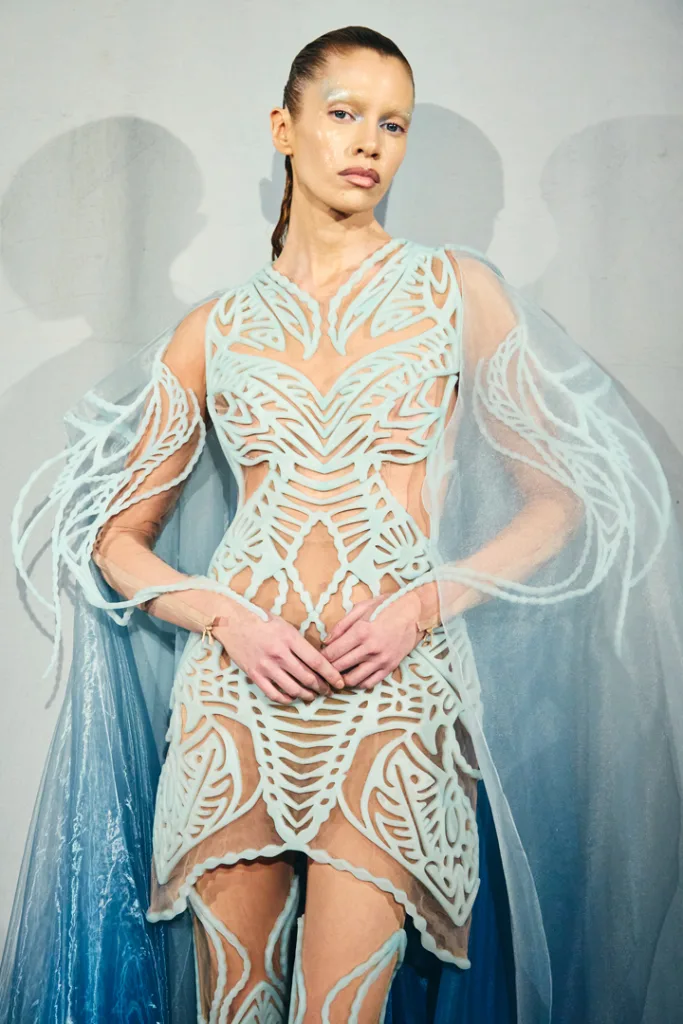
A race against the clock
The prospect of harvesting enough algae to create an entire dress was already daunting. Then, Van Herpen sent Bellamy her concept sketch.
Unlike the flat textile that Bellamy had developed for “Lucid Life,” Van Herpen’s haute couture idea involved a complex pattern of raised ridges and swirls, each sewn onto a transparent panel to give the illusion that they were rising from the model’s own skin.
“I presented Iris with a rule book saying, these are the constraints for the design, and you want to work within these parameters. And she sent back her vision for the garment, and it looked absolutely nothing like the rules I proposed,” Bellamy says. “So we actually ended up developing a completely bespoke biotechnology process to make Iris’s design feasible.”
Bellamy had just two months to figure out a new way to encapsulate the algae before he had to hand over the materials to Van Herpen’s atelier. Bellamy and Van Herpen’s team constructed an entire dedicated algae farm at the University of Amsterdam, where he created “hundreds and hundreds” of prototypes. Bellamy moved to the city to monitor the farm, testing countless new combinations of nutrient gels and membrane materials in a race against the clock.
“The apartment I was living in had samples everywhere. For two months, I was setting my alarm every couple of hours in the night to wake and make sure a new part of the process happened,” he says. “It was exhausting—I don’t even think Iris knows this, but the first material sample that properly worked happened the night before the deadline to make all the materials.”
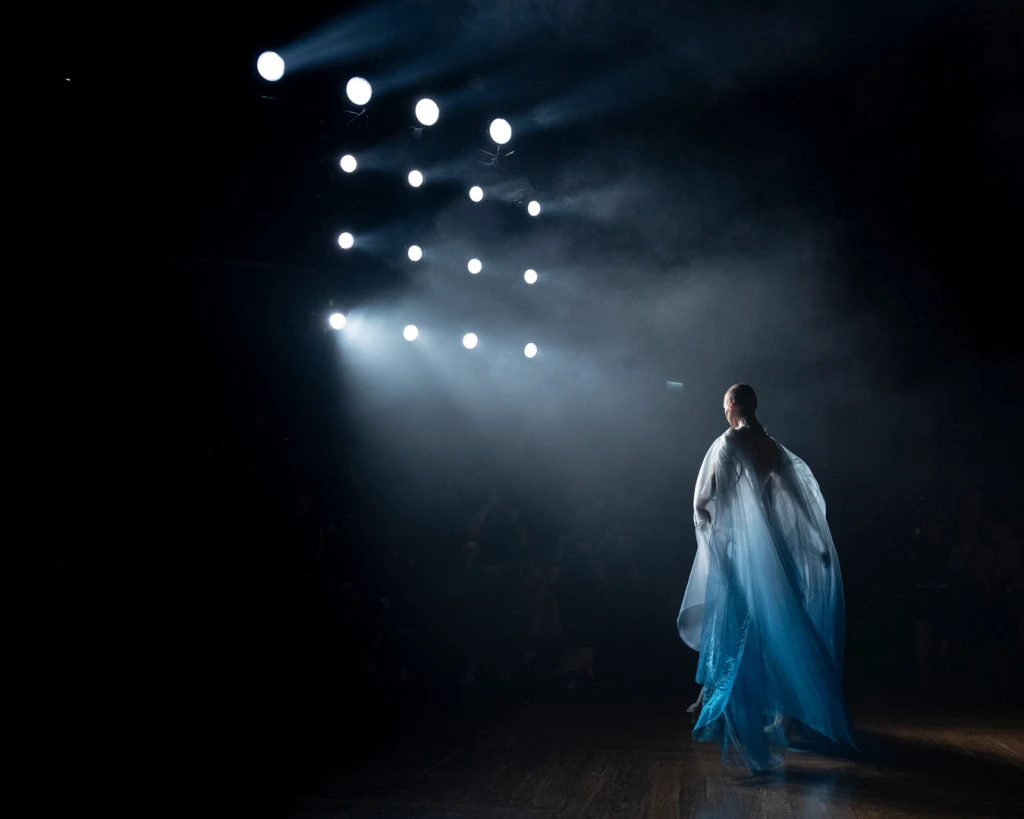
125 million microalgae face a near-death experience
The day after the breakthrough, Bellamy worked frantically to turn 125 million microalgae into a workable material for the designers at Van Herpen’s atelier. When it was finally ready, the next challenge began: keeping the algae alive until the show.
Bellamy says the microalgae are fairly resilient. However, temperature extremes can kill them, and Van Herpen’s designers were working in a studio without air-conditioning in the midst of a heat wave nearing 100-degree temperatures. To prevent heat-induced algae death, Bellamy commissioned a custom climatic chamber to store the dress when it wasn’t being actively sewn. The chamber (which vaguely resembles a prop one might find on the set of Star Wars) was designed to maintain optimal temperatures and humidity, as well as to mimic the effect of the sun.
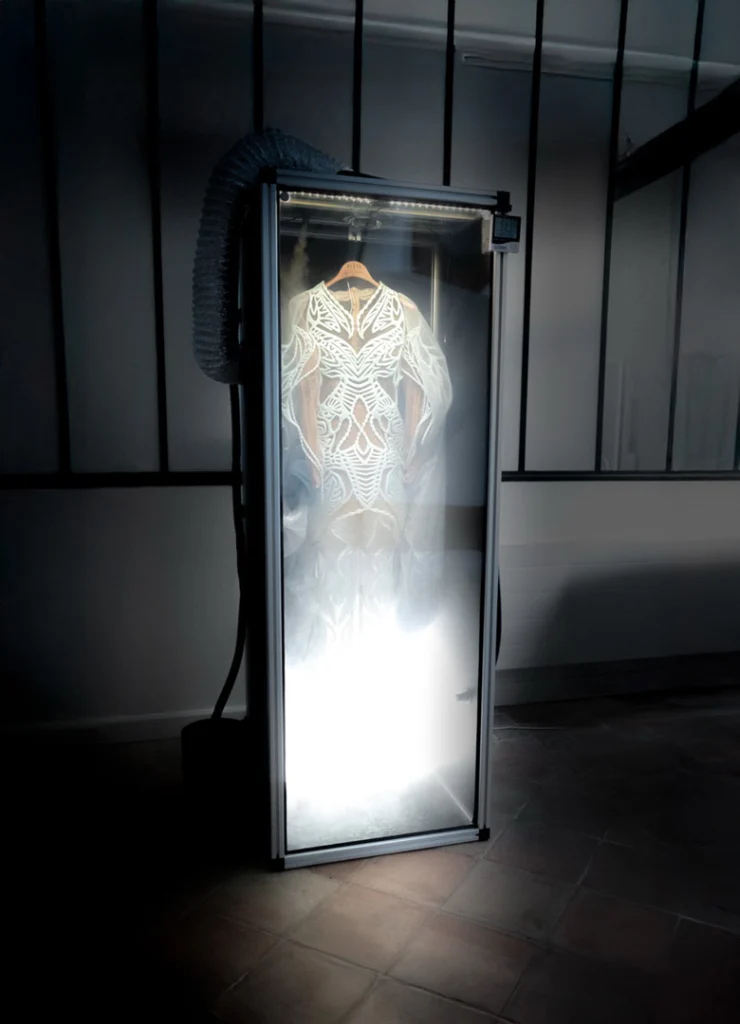
After five weeks, the sewing and fitting processes were complete. The dress was packed into the climatic chamber, loaded onto a refrigerated truck, and driven from Amsterdam to Paris for fashion week. There, just six days before the show, the unthinkable happened: Another heat wave rolled in. As Van Herpen’s team started making the final tweaks on the gown, they noticed that its front bust panel was no longer glowing.
“I got a call, and it was like, ‘The garment got really hot, and it’s not lighting up anymore,’” Bellamy says, noting that he got on the next plane to Amsterdam and restarted the farm. “We got everything going, and worked through the night for a few nights to try and create this huge volume of material. We ended up having to book four seats on a bus, and we had an overnight bus to Paris to be able to get the material there on time,” he says. “A few designers worked through the night again, and the team managed to then rebuild the garment just on time.”
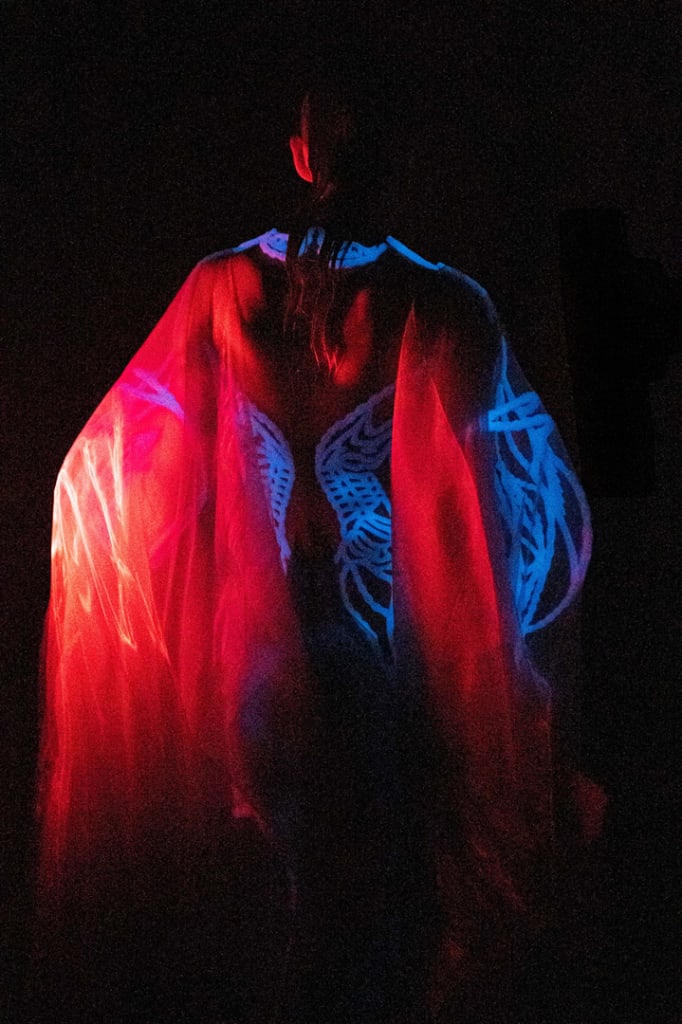
A living process
In the final days before the fashion show, the dress’s circadian rhythm had to be prepped to ensure it would light up at a midday showing. Bellamy artificially altered its day-night cycle by turning the climatic chamber’s light off during the day and back on at night—meaning that just before Maxwell walked in the show, she had to be dressed in a backstage blackout tent.
When Maxwell finally took to the runway, the lights in the room were fully dimmed. The audience could see in intricate detail as the tapping of her fingers over the garment illuminated individual panels. Her first steps into the space looked almost like the dress was moving of its own accord; floating through the air like an ethereal blue hologram.
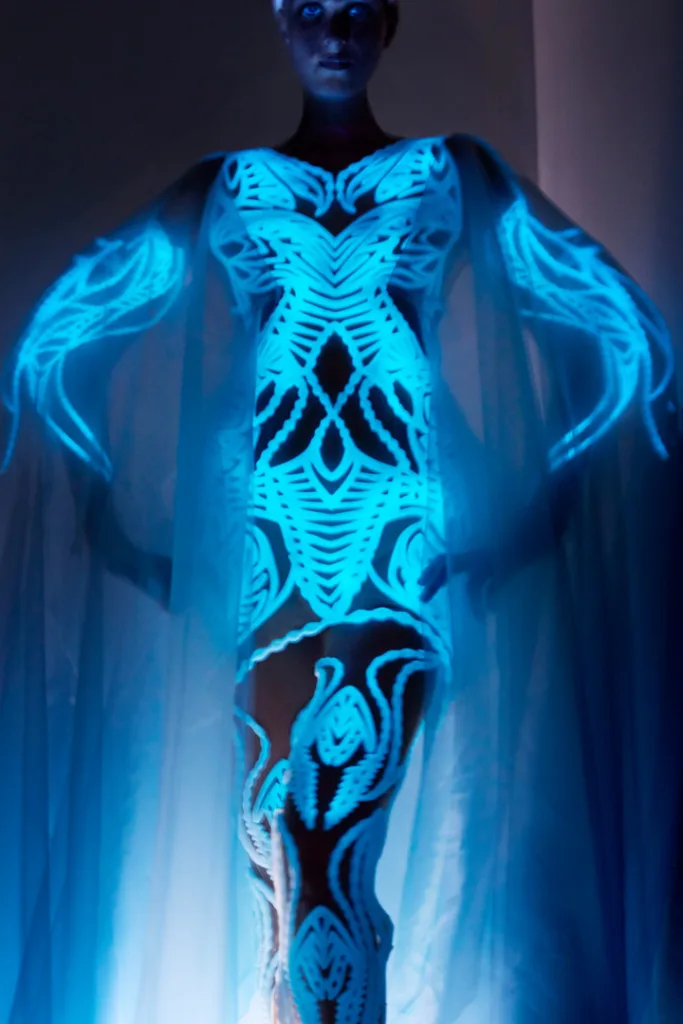
Now that the show is complete, Bellamy says he’s not sure how long the dress will live. In the meantime, he hopes it can help people rethink their relationship with materials and nature.
“Everyone who’s been involved in this project in the atelier has undergone a really profound change, because as they’ve been making this garment, they’ve had to care for it at the same time,” Bellamy says. “We built this language where we say, ‘Oh, they’re grumpy,’ or ‘Oh, they’re happy.’ And some people might say, ‘You can’t anthropomorphize an organism!’ But equally, it’s necessary to give it emotions; it’s necessary to communicate with it to be able to really understand it. For me, the message is about trying to change that relationship to materials and nature. The team here in the atelier will be absolutely devastated if this garment dies because they’ve cared for it and nurtured it.”
What's Your Reaction?
 Like
0
Like
0
 Dislike
0
Dislike
0
 Love
0
Love
0
 Funny
0
Funny
0
 Angry
0
Angry
0
 Sad
0
Sad
0
 Wow
0
Wow
0







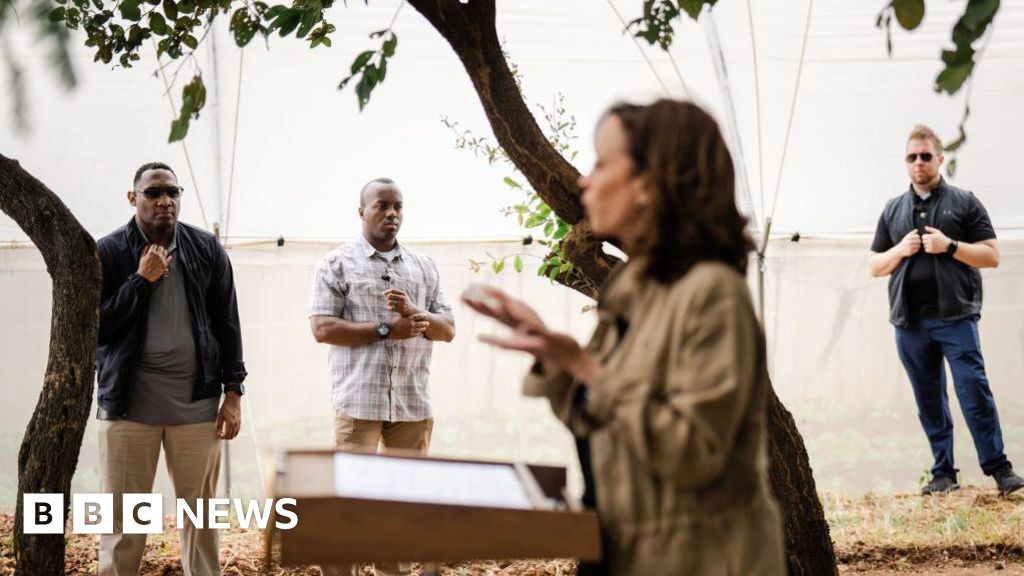
























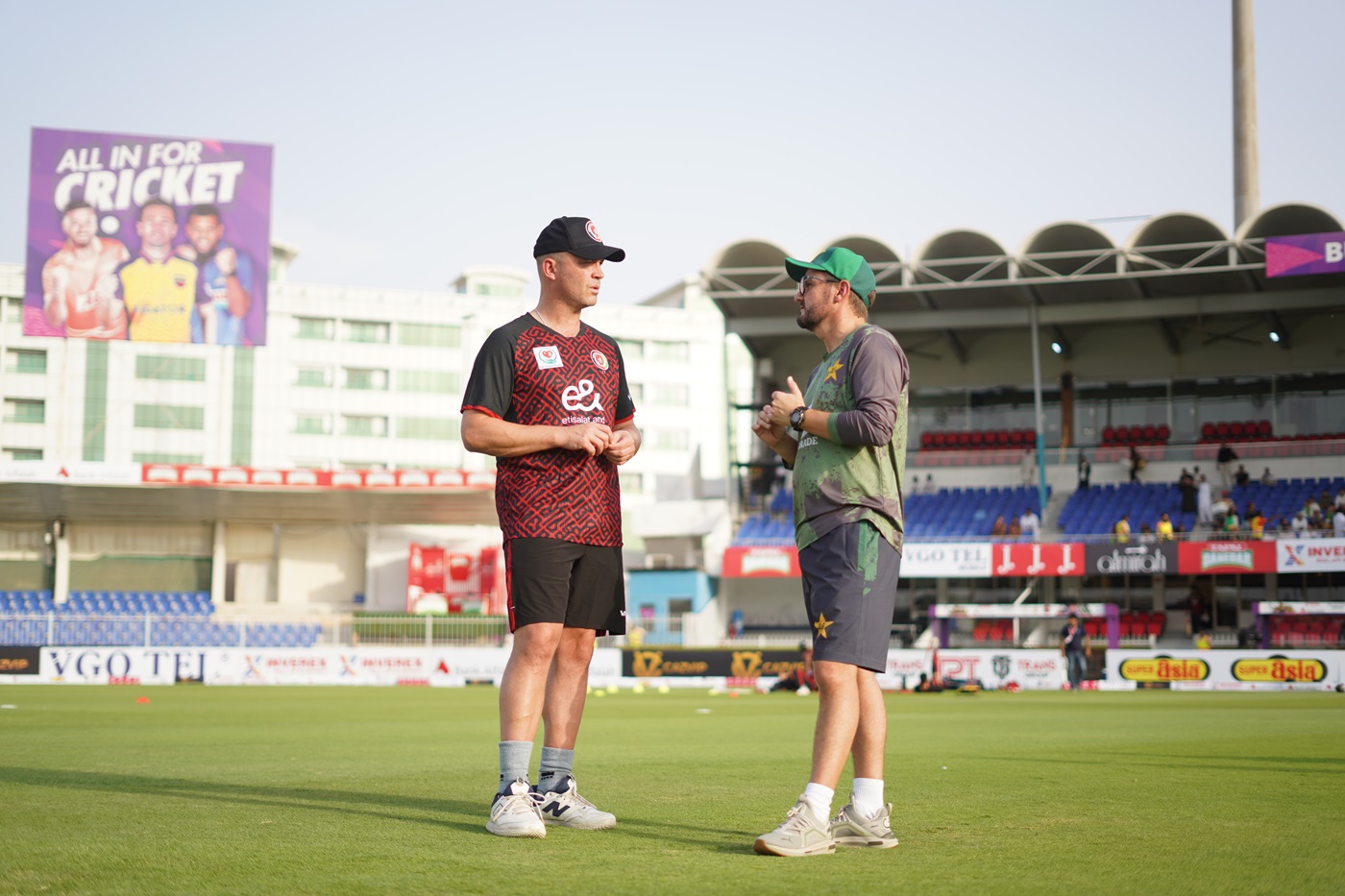


















![Øyunn finds "New Life" in latest single [Music Video]](https://earmilk.com/wp-content/uploads/2025/08/oyunn-800x379.png)
